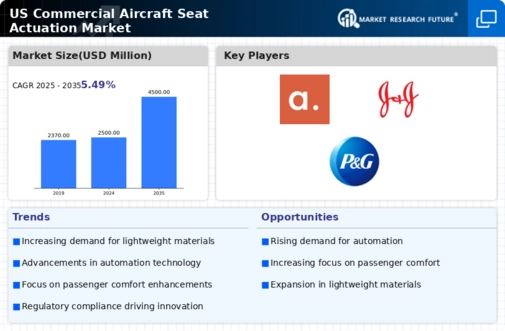Increasing Air Travel Demand
The commercial aircraft-seat-actuation market is experiencing a surge in demand due to the increasing number of air travelers in the United States. As airlines expand their fleets to accommodate this growth, the need for advanced seat actuation systems becomes more pronounced. In 2025, the air travel industry is projected to grow by approximately 5% annually, leading to a corresponding rise in the demand for innovative seating solutions. Airlines are investing in modern aircraft equipped with state-of-the-art seat actuation technologies to enhance passenger comfort and operational efficiency. This trend indicates a robust market potential for manufacturers and suppliers within the commercial aircraft-seat-actuation market, as they strive to meet the evolving needs of airlines and their customers.
Focus on Passenger Experience
Enhancing passenger experience is a primary focus for airlines, which directly impacts the commercial aircraft-seat-actuation market. Airlines are increasingly recognizing that comfortable seating can significantly influence customer satisfaction and loyalty. As a result, there is a growing trend towards the development of seat actuation systems that offer features such as adjustable lumbar support, reclining capabilities, and personalized settings. In 2025, it is projected that airlines will allocate approximately $2 billion towards upgrading their seating systems to improve passenger comfort. This investment reflects a broader industry shift towards prioritizing the passenger experience, thereby driving demand for innovative seat actuation solutions within the commercial aircraft-seat-actuation market.
Regulatory Compliance and Safety Standards
The commercial aircraft-seat-actuation market is significantly influenced by stringent regulatory compliance and safety standards imposed by aviation authorities in the United States. These regulations necessitate the incorporation of advanced actuation systems that ensure passenger safety and comfort. Compliance with Federal Aviation Administration (FAA) guidelines is critical for manufacturers, as non-compliance can lead to severe penalties and operational disruptions. As a result, companies are increasingly investing in research and development to create seat actuation systems that not only meet but exceed these regulatory requirements. This focus on safety and compliance is likely to drive innovation and growth within the commercial aircraft-seat-actuation market, as stakeholders prioritize the development of reliable and safe seating solutions.
Technological Integration in Aircraft Design
The integration of advanced technologies in aircraft design is a key driver for the commercial aircraft-seat-actuation market. Innovations such as electric actuation systems, which offer improved reliability and reduced maintenance costs, are becoming increasingly prevalent. In 2025, it is estimated that the market for electric actuation systems will account for over 30% of the total seat actuation market share. This shift towards technology-driven solutions is not only enhancing the performance of seat actuation systems but also contributing to overall aircraft efficiency. As manufacturers continue to adopt these technologies, the commercial aircraft-seat-actuation market is poised for substantial growth, driven by the demand for modern, efficient, and reliable seating solutions.
Competitive Landscape and Market Consolidation
The commercial aircraft-seat-actuation market is characterized by a competitive landscape that is witnessing consolidation among key players. Mergers and acquisitions are becoming more common as companies seek to enhance their product offerings and expand their market reach. This trend is likely to lead to the emergence of larger entities capable of investing in advanced technologies and research. In 2025, it is anticipated that the top five manufacturers will control over 60% of the market share, indicating a shift towards a more concentrated market structure. This consolidation may drive innovation and efficiency, as companies leverage their combined resources to develop cutting-edge seat actuation systems that meet the evolving demands of airlines and passengers.














Leave a Comment